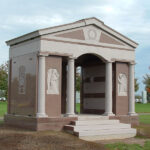Where ‘Mausoleum’ Gets Its Meaning

There are many famous mausoleums:
The Taj Mahal, the tomb of the first emperor of Qin in China, and the tomb of Cyrus the Great, the founder and ruler of the 6th-century Persian Empire, are only a few.
The Taj Mahal
, an immense memorial carved out of marble between 1632 and 1653 by the Mughal emperor Shah Jahan in memory of his favorite wife, ranks among the wonders of the world. So does the tomb of the first emperor of the Qin dynasty in China, which contains the 8,000 soldiers, 130 chariots, 520 horses and 150 cavalry horses of his terra cotta army. The tomb of Cyrus the Great was a stopover for Alexander the Great during his conquest of Asia and remains a prominent monument in modern-day Iran.
But one monument outranks them all
— at least in terms of linguistic influence. The meaning of mausoleum don’t come from any of the aforementioned sites, but rather from an ancient tomb (now ruined) more obscure to modern observers: The Mausoleum at Halicarnassus — or, the Tomb of Mausolus.
The Mausoleum at Halicarnassus
was built over a period spanning three years (between 353 and 350 BC) to house the remains of Mausolus, a satrap of ancient Persia, and — during its heyday — stood approximately 45m (or 148 ft) tall. On each of the four sides of the famed mausoleum were four sculptural reliefs carved by four of the ancient world’s most esteemed sculptors: Leochares, Bryaxis, Scopas of Paros, and Timotheus. The finished memorial was so beautiful it was christened by one observer one of the Seven Wonders of the Ancient World.
Unfortunately, the building itself was destroyed by earthquakes between the 12th and 15th centuries.
Even though his material legacy has died out, Mausolus lives on in the legend of his grand memorial — so great it became the term we use today to describe all above-ground tombs.
